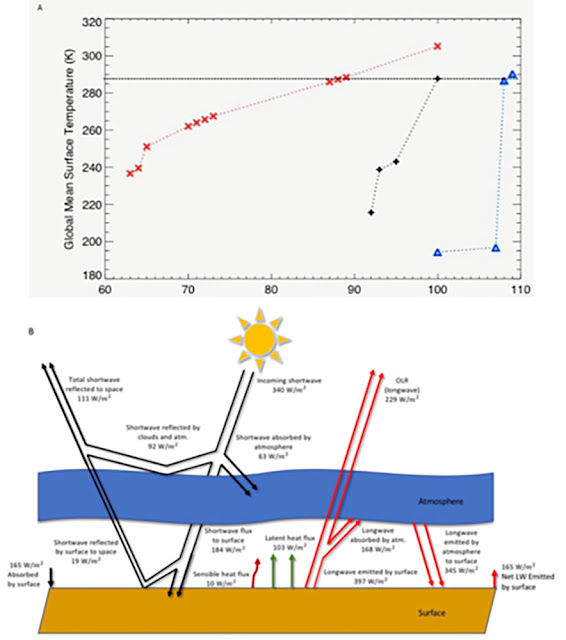Well again this week we are waiting for the next potential transit of the 60 Starlinks satellites, hopefully still all in a line, to make a transit over Orange County and the weather forecast is looking very poor for that event, so let's review some of the ongoing weather and climate predictions for exoplanets.
This week Professor Aomawa Shields, UCI, talked at the UCI physics department colloquium on the topic, "Recipe for a Habitable Planet."
 |
| UCI Professor Aomawa Shields speaks on habitable planets at UCI physics colloquium (Source: Palmia Observatory) |
She introduced the topic of planet habitability by saying that the subject has advanced much further than the older idea of a planet being located at the right distance from its star, that is in the Goldilocks Zone. While water may not be necessary for all forms of possible life, it is the most logical place to look for as part of the study of exoplanets. There are so many more factors that affect the right distance and she introduced this list of applicable factors that are now part of the study of planet habitability. How these various factors influence the availability and stability of water on the planet's surface is a key area of study.
 |
| The emerging and multidisciplinary field of exoplanet climatology (Source: A. Shields, arXiv:1909.04046) |
The planet's surface temperature is determined by the interplay of all of these factors but in the end they all are but subparts of an energy balance equation. The solar radiation from the planet's star is partially reflected and absorbed and the planet's surface and atmosphere radiates emitted infrared radiation indicative of its blackbody temperature as shown in the simplified energy balance diagram below.
 | |
|
 |
| Professor Shields described how Earth atmosphere would freeze out without the sun (Source: Fritz Leiber, "A Pail of Air") |
So, starting with this first example, you might also have heard of the "Eyeball Earth" as another example of a possible exoplanet climate state. In the drawing below, from one of Shield's published papers, you can see a planet, tidally locked in its orbit around its sun and the substellar point has a liquid water ocean, but the other remaining surface is continually frozen. This would be one strange place and it might be too hot for life at some parts of the substellar point, but ok at other locations. So, we can see that until the actual conditions on exoplanets are observed, ongoing climate modelling and simulation should be wide ranging for all sorts of possibilities.
 |
| One exotic tidally locked exoplanet possibility (Source: A. Shields, arXiv:1909.04046) |
One of the most significant factors of planetary surface temperature is the albedo of the surface materials like land, vegetation, snow and ice. The albedo is the amount of incoming radiation that is reflected. The most significant finding for me was that the albedo of snow and ice is very wavelength dependent. You can see this quite clearly in this chart showing the Spectral Energy Distribution (SED) and its effect on the reflectivity of different surfaces. We get used to thinking that snow and ice are very reflective of incoming solar radiation. And that is true for a star like our sun, but look how the albedo drops very low for incoming radiation from an M type star.
 |
| Spectral variation of surface albedo and exoplanet/star temperature potential (Source: A. Shields, et al, arXiv:1910.05439v1) |
These factors of the star's SED and assumed makeup of the exoplanet's surface and atmosphere can be incorporated into the general circulation models (GCM) to study the ranges and factors determining the surface temperature. The computer models divide the planet's surface into a bunch of grids and the atmosphere is further divided into layers. This way all of the factors that are part of the heat balance equation are included for the entire planet surface.
 |
| Using general circulation modelling to estimate surface temperature (Source: A. Shields, arXiv:1909.04046) |
An example of GCM modelling shows up in this IPCC slide for greenhouse warming history and predictions for future warming. The explanation for greenhouse warming is tied directly to the Earth's atmosphere being mostly transparent to the incoming solar radiation and that which is not reflected by clouds and the surface is absorbed by the surface. But the atmosphere is not completely transparent to the infrared blackbody radiation from the surface. The uncertainty in future temperatures has a lot of variance due to unknown mitigation approaches and continued emissions of greenhouse gases not the underlying physics.
 |
| Using general circulation modelling to estimate surface temperature of Earth (Source: A. Shields, arXiv:1909.04046) |
When these general circulation models are applied to exoplanet climatology studies we get an expanded view of the Goldilocks zone possible around different types of stars, in this study for F, G and M types stars. In the figure below you can see an example simulation with these three types of stars and some amounts of reflected and absorbed radiation by the clouds and surface layers. The interaction of the radiation with the atmosphere and surface depend very much of the wavelength of received radiation and the blackbody emitted radiation which is a function of the temperature.
Hmm, why do brighter F type stars seem to show a wider range of instellation possible that can result in an exoplanet's surface temperature range for liquid water than do the dimmer G and M stars? We already saw in the discussion of spectral energy distribution that the star's peak radiation wavelength and the wavelength dependence of the planet's surface and atmospheric albedo interact to give surprising results in the heat balance equation. But, I'm not sure if I see why the plotted results are as shown? It seems to say that there are more ways to have liquid water on an exoplanet around an F type star than type G (like our sun) and M type dwarf stars. Do you have an idea of what this chart means?
 |
| Exoplanet global mean temperature for different star types and instellation (Source: A. Shields, et al, arXiv:1909.07418v1) |
Now after this look at long term planetary climatology we can return to the shorter term weather of this planet, Earth, and see if we are going to have any chance at all of seeing the 60 Starlinks satellites as they pass overhead in the morning skies of Orange County on November 20 and 21. Hmm, as you can see in the following Night Sky app screenshot, Wednesday November 20 morning looks very poor with clouds and rain. The morning of Thursday November 21 looks a little better in that the storm is mostly dissipating.
 |
| Scope Nights iPhone app shows poor chance for early morning seeing Starlink string of lights (Source: Palmia Observatory) |
Ok, here it is early on Wednesday, November 20 morning and the sky is completely clouded out. The rain just stopped for a bit so I chanced to get this DSLR photo with 2 second exposure. Nope, can't see anything, no stars nor Starlink satellites, through those clouds! The good news is that predicted transit opportunities will occur for the next couple of days. The updated times are closer to 5:14 AM, so stay tuned for the next blog post where we will identify the next best viewing options.
 |
| Hopes to observe again the Starlink string of pearls clouded out, DSLR, 130mm, 2 seconds (Source: Palmia Observatory) |
Until next time,
Resident Astronomer George
Be sure to check out over 300 other blog posts on similar topics
If you are interested in things astronomical or in astrophysics and cosmology
Check out this blog at www.palmiaobservatory.com

No comments:
Post a Comment